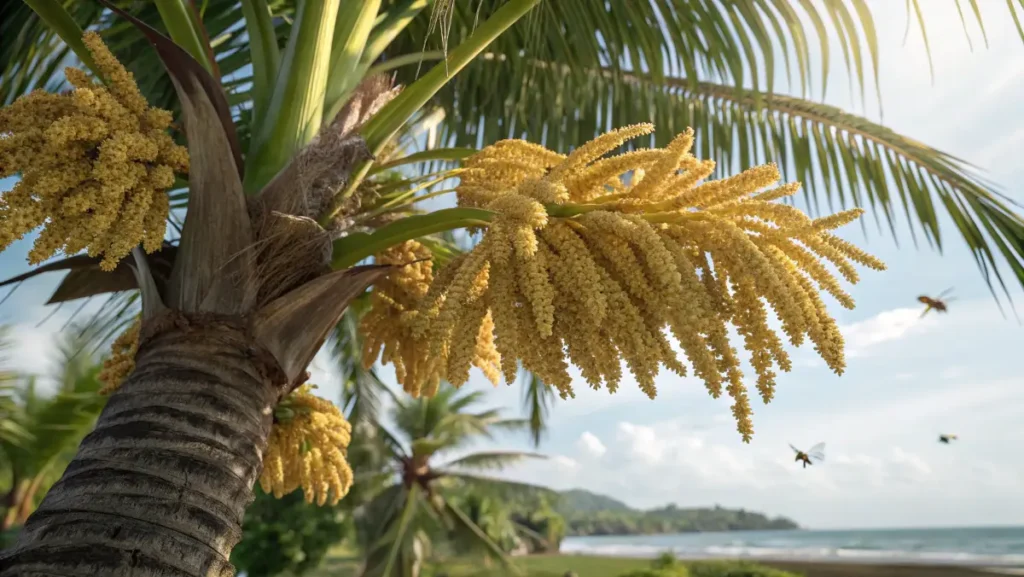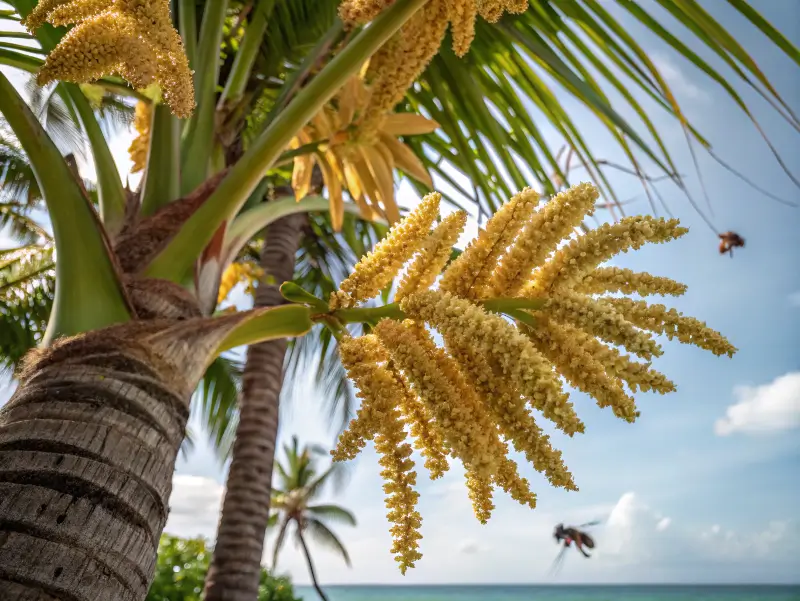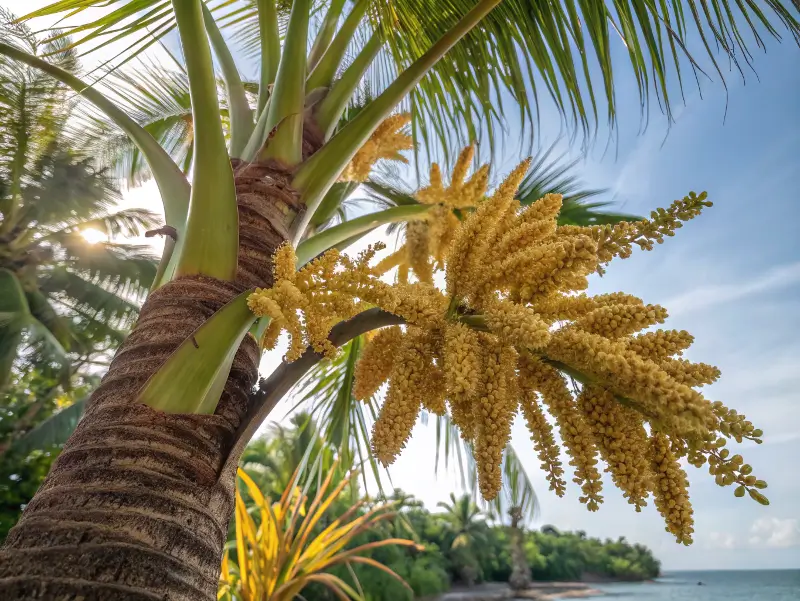
In This Article
Coconut flower (Cocos nucifera) is a tropical beauty best known for its golden, feather-like blossoms that grow in dramatic clusters. These stunning flowers not only lead to coconuts but also produce sweet nectar and sap. The fast-growing palm can reach towering heights, thriving in full sun with regular watering. It’s not pet-safe, so caution is needed. While not a houseplant, it’s easy to grow in warm, humid outdoor climates.
Understanding Coconut Flower Biology and Structure
What is a Coconut Flower? Anatomy and Inflorescence Structure
Let’s face it – most people think coconuts just magically appear on trees! But here’s the thing: every coconut starts as part of a coconut flower cluster called an inflorescence.
Now, this isn’t your typical garden flower. Instead, we’re talking about a massive branching structure that can be up to 3 feet long! The palm inflorescence looks kind of like a giant feather duster when it first emerges from between the fronds.
What’s really cool is that each cluster contains hundreds of tiny individual blossoms. Furthermore, these delicate structures are protected by a tough outer covering called a spathe – think of it as nature’s protective wrapper that keeps everything safe during development.
The anatomy is pretty complex when you really look at it. Each inflorescence has a main stalk called a rachis, with dozens of smaller branches called rachillae. These branches hold all the individual blossoms that will eventually produce coconuts or simply provide pollen for reproduction.
Male vs Female Coconut Flowers: Understanding Sexual Dimorphism
Here’s where things get interesting (and a bit steamy, if you will). The palm inflorescence has both male and female blossoms on the same structure. However, they don’t all open at once – that would be too easy!
The male blossoms are tiny and numerous: • They open first (usually 7-10 days earlier) • Produce loads of pollen • Cover most of the inflorescence • Stay open for only a few days
Meanwhile, the female blossoms are fewer but mightier: • Only 5-20 per inflorescence • Much larger than males • These babies become the actual coconuts • Remain receptive for weeks
This timing difference is called “protandry,” and honestly, it’s pretty smart. By opening at different times, the tree avoids self-pollination and keeps the gene pool healthy. It’s like nature’s built-in dating app – no swiping required!
The Coconut Palm Flowering Timeline: From Bud to Bloom
So when does a coconut flower actually show up? Well, patience is key here! A coconut palm typically starts producing inflorescences when it’s 4-6 years old. But once it gets going, it’s like clockwork.
The development cycle is pretty predictable: • New buds form every 3-4 months • Each bud takes about 6 months to fully develop • Peak blooming happens during warmer months • Multiple stages are visible on mature trees simultaneously
During summer 2024, I noticed my palms were particularly productive – probably because of the consistent heat and humidity we had that season. Temperature plays a huge role in timing, with optimal conditions around 80-85°F speeding things up.
The Coconut Flower Inflorescence: Nature’s Complex Design
How Coconut Flowers Develop on Palm Trees
The development of palm inflorescences is absolutely fascinating to watch unfold over time. It starts as a small bud tucked between the palm fronds, and over several weeks, it slowly pushes through the protective spathe covering.
Initially, the whole thing looks like a giant sword poking out from the tree crown. Then, as the spathe begins to split open, you get your first glimpse of the actual cluster inside. It’s like unwrapping nature’s gift – suddenly this explosion of tiny branches and blossoms emerges.
The Role of Spathe in Coconut Flower Protection
That tough spathe I mentioned earlier? It’s basically the bodyguard for the developing inflorescence. This fibrous covering protects the delicate structures from: • Heavy rain and tropical storms • Hungry insects and birds • Physical damage from strong winds • Temperature fluctuations
When the spathe finally splits open, it creates this amazing fountain-like display. Plus, here’s a pro tip: this splitting moment is the perfect time to start tapping for nectar if that’s your goal.
Pollination Process in Coconut Palm Flowers
Most palm inflorescence pollination happens thanks to wind and various insects working together. The male blossoms release enormous clouds of pollen that get carried by air currents to female structures on other trees.
Interestingly, bees absolutely love these palm blossoms! They’re drawn to the abundant nectar and inadvertently help with pollination. If you’re growing other palms like the King Palm Tree, you’ll notice similar pollination patterns across different palm species.
Coconut Flower Sap and Nectar: Liquid Gold from Palm Trees

Harvesting Coconut Flower Nectar: Traditional Tapping Methods
Now we’re getting to the good stuff! Palm nectar tapping is an ancient art that’s seeing a huge comeback. The process involves making strategic cuts on the inflorescence before it opens fully and collecting the precious sap that flows out.
Traditional tappers use these time-tested techniques: • Make a clean diagonal cut on the main stalk • Attach a collection container (usually bamboo or food-grade plastic) • Collect sap twice daily – early morning and late evening • Gradually extend the cut to maintain flow
The timing is absolutely crucial here. You’ve got to catch the coconut flower structure at just the right developmental stage, or you’ll miss your window entirely.
Coconut Flower Drops: The Morning Collection Process
Here’s something I learned the hard way: the best palm nectar comes from the early morning collection. Fresh nectar at sunrise is crystal clear and has this amazing subtle sweetness that’s unlike anything else.
However, here’s the catch – this stuff ferments incredibly quickly in tropical heat. We’re talking hours, not days. If you don’t process it fast or store it properly, you’ll end up with palm wine instead of sweet nectar.
From Fresh Sap to Coconut Sugar: Processing Methods
Converting fresh palm nectar into crystallized sugar is straightforward but requires attention. The basic process involves slowly boiling down the fresh sap until all the water evaporates and you’re left with beautiful golden crystals.
The whole process reminds me of making maple syrup, except the flavor profile is completely different. Palm sugar has this incredible subtle caramel taste with hints of butterscotch that’s amazing in coffee and baking.
Health Benefits of Coconut Flower Products
Nutritional Profile of Coconut Flower Nectar
Let’s talk nutrition because palm nectar products are genuinely impressive. According to recent studies, fresh sap contains significant amounts of important minerals:
• Potassium (excellent for heart health) • Iron (crucial for healthy blood)
• Zinc (essential for immune system) • Magnesium (important for muscle function)
Moreover, fresh nectar also contains amino acids and B vitamins that you won’t find in regular white sugar. What really surprised me was the presence of inulin, a prebiotic fiber that feeds beneficial gut bacteria.
Is Coconut Flower Sugar Healthy? Comparing to Regular Sugar
This is probably the most common question I get about coconut flower products. While it’s still sugar and should be used in moderation, crystallized palm sugar does have some advantages over regular white sugar.
The glycemic index is notably lower (around 35 compared to 65 for regular sugar), which means it doesn’t spike your blood sugar as dramatically. Additionally, those minerals actually survive the processing, unlike heavily refined white sugar.
That said, don’t go crazy with it just because it’s “healthier.” Sugar is still sugar, you know?
Mineral Content and Vitamin Benefits of Coconut Sap
The USDA has documented the mineral content of palm-derived products, and the numbers are impressive for a sweetener. The potassium content is particularly noteworthy – it’s actually higher than most fruits!
Iron levels are also surprisingly good, which could be helpful for people dealing with iron deficiency. The B vitamin content includes thiamine, riboflavin, and niacin in small but measurable amounts.
Culinary Uses and Applications of Coconut Flower Products

Coconut Flower Sugar in Cooking and Baking
I’ve been experimenting with crystallized palm sugar in my kitchen for months now, and it’s been a total game changer. The subtle caramel notes work beautifully in:
• Chocolate chip cookies (adds incredible depth) • Coffee cakes and muffins • Homemade granola • Asian-inspired stir-fries • Barbecue rubs and marinades
However, this sugar doesn’t dissolve quite like regular sugar, so you might need to adjust your technique. For baking, I often dissolve it in the liquid ingredients first.
Traditional Uses of Coconut Nectar in Southeast Asian Cuisine
In countries where coconut palms grow naturally, fresh nectar has been central to cuisine for centuries. Fresh sap is often consumed as a refreshing drink, while fermented versions create palm wine or vinegar.
Traditional desserts frequently feature palm products as both sweetener and flavoring agent. The taste is distinctly different from coconut meat or milk – more floral and complex.
Modern Recipes Using Coconut Flower Sweeteners
Health-conscious cooks are rediscovering palm-derived sweeteners and creating amazing modern applications. I’ve seen incredible recipes trending lately for: • Paleo-friendly desserts • Vegan baking projects
• Low-glycemic smoothie bowls • Artisanal chocolate making • Craft cocktails using palm syrup
The versatility has really surprised me. Plus, it photographs beautifully for Instagram – that gorgeous golden color just screams “artisanal.”
Coconut Flower Cultivation and Commercial Production
Growing Coconut Palms for Flower Production
If you’re thinking about growing coconut palms for nectar production, location is everything. These trees need consistent tropical conditions with year-round temperatures above 70°F and high humidity.
Unlike ornamental palms such as the Sylvester Palm Tree, coconut palms grown for nectar require specific positioning for easy access to developing inflorescences.
Commercial Coconut Flower Tapping Operations
Large-scale nectar tapping operations are fascinating and quite different from backyard efforts. Commercial tappers often work multiple trees simultaneously and have refined techniques to maximize yield while maintaining tree health.
The economics are interesting – a single productive tree can yield 1-4 liters of sap per day during peak season. With proper processing, that translates to serious income potential in the right markets.
Sustainable Harvesting Practices for Coconut Flowers
Responsible tapping practices are crucial for tree health. The good news is that proper nectar harvesting doesn’t harm healthy trees when done correctly. Many experienced tappers alternate between tapping for nectar and allowing natural coconut production.
Environmental Impact and Sustainability of Coconut Flower Harvesting
Eco-Friendly Aspects of Coconut Palm Cultivation
Palm nectar production is inherently sustainable because it doesn’t require cutting down trees or intensive farming practices. Coconut palms are excellent carbon absorbers and help prevent coastal erosion in tropical regions.
Supporting Local Communities Through Coconut Flower Production
The growing demand for coconut flower products has created meaningful income opportunities for rural communities in tropical countries. This economic boost helps preserve traditional knowledge while providing modern market access.
FAQ
What is the flower in the coconut?
The coconut flower isn’t actually inside the coconut – it’s the reproductive structure that appears on coconut palm trees before coconuts develop. Each inflorescence contains hundreds of tiny male flowers and several larger female flowers that eventually become coconuts.
How rare is a coconut flower?
Coconut flowers aren’t rare on mature palm trees! A healthy coconut palm produces new clusters every 3-4 months. However, the window for tapping fresh nectar is limited, making fresh sap relatively precious.
Does coconut flower taste like coconut?
Coconut flower nectar doesn’t taste much like coconut meat or milk. Instead, it has a mild, sweet flavor with subtle floral notes and hints of caramel. The taste is much more delicate and complex than other coconut products.
Is coconut flower sugar healthy?
Coconut flower sugar contains minerals like potassium, iron, and zinc, and has a lower glycemic index than regular sugar. However, it’s still sugar and should be consumed in moderation as part of a balanced diet.
